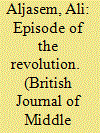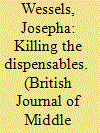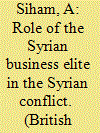|
|
|
Sort Order |
|
|
|
Items / Page
|
|
|
|
|
|
|
| Srl | Item |
| 1 |
ID:
186072


|
|
|
|
|
| Summary/Abstract |
Political Opportunity Structure (POS) theorists have paid attention to either the structural factors or to the agential ones while studying social movements. Through the nexus of structure and agency this article explains the collective action of the students of Aleppo University between 2011 and 2013 as one episode of the Syrian Revolution. I argue that structures alone are not enough to facilitate collective action. It is the agency of the social movement participants that mend the structures to open more opportunities. Through applying Tilly and Tarrow’s properties of a regime to the Syrian case I explore the opportunities that the challengers took to advance their claims to sustain their movement for three years. I argue, however, that the properties of the Syrian regime were not equally significant. By capitalising on their agency, I highlight the everyday micro practices of the students in challenging the regimes inside the campus. Finally, I look at the prominence of some properties over others and empirically show how these regime properties eventually led to the end of the movement inside the campus in 2013.
|
|
|
|
|
|
|
|
|
|
|
|
|
|
|
|
| 2 |
ID:
186073


|
|
|
|
|
| Summary/Abstract |
In 2013, Aleppo province was engulfed in violence. The Syrian Arab Army (SAA) and affiliated Shi’a militias executed a campaign of massacres in the rural areas located on the eastern fringes of the province. The violence caused an exodus from this region, eventually dissipating local rural communities entirely. What can explain such extreme and brutal political violence perpetrated at a local level in the east Aleppo countryside throughout 2013? To find an answer, I analyse the personal accounts of those who witnessed the violence and YouTube videos. Taken together, these sources provide a visceral description of the massacres—in particular the summary executions in the village of Rasm al-Nafl, as a case study of extreme violence in one of the poorest rural areas of Syria. Problematizing mono-causal sectarian explanations, I argue that a deeper non-sectarian complex of rurality and a process of subaltern othering in combination with opportunism, governmental retribution, and strategic military concern for territorial control in order to secure alternative supply routes to Aleppo, ultimately led to the eradication of life and cultural genocide in these rural areas.
|
|
|
|
|
|
|
|
|
|
|
|
|
|
|
|
| 3 |
ID:
186066


|
|
|
|
|
| Summary/Abstract |
In 2011, the Syrian uprising rapidly escalated into a large-scale, complex, multi-dimensional civil war. Over a period of six years, the violence spread and became more intense, hundreds of thousands of people were killed, and the economic infrastructure and civic life of the region were devastated. The resultant fragmentation of Syrian territory was accompanied by the large-scale internal and external displacement of the population. Local activists, civil society members, and ordinary citizens have engaged in various practices to expose the violence. Such practices range from the uploading of videos to the internet and social media discussions, to more organized forms of activism, such as the creation of NGOs and the proper, systematic documentation of events. Since 2011, and in particular with the rise of ISIS, academics, policy makers, and the global media have taken a keen interest in the spectacle of violence in Syria.
|
|
|
|
|
|
|
|
|
|
|
|
|
|
|
|
| 4 |
ID:
186069


|
|
|
|
|
| Summary/Abstract |
While the administrations of Hafez and Bashar al-Assad employed torture regularly as a tool of authoritarian governance, this usage changed dramatically in nature as the revolution moved from protests to insurgency, which posed an increasingly significant threat to the regime’s survival. In the counterinsurgency literature, torture’s function is generally tied to intelligence gathering. In the context of Syria’s post-2011 Counterinsurgency (COIN) campaign, torture functioned more as a way to intimidate the population, forcing them to explicitly choose a side—especially in contested zones. The threat posed by the uprising amplified the scale, form, targeting, and purpose of torture, expanding it significantly. This article traces these dynamics, not only to explain the changing logics and practices of torture in Syria, but also to identify key actors, structures, and sites of analysis. It attempts to avoid falling into the normative trap of simply condemning torture, by moving its examination into a more analytical space, thereby demonstrating how torture can perform a critical function beyond intelligence gathering within an authoritarian COIN campaign.
|
|
|
|
|
|
|
|
|
|
|
|
|
|
|
|
| 5 |
ID:
186070


|
|
|
|
|
| Summary/Abstract |
As Bashar al-Assad succeeded his father Hafez in 2000, a new ‘state bourgeoisie’ was created in Syria through means of liberalization and neopatrimonial approaches. In addition to the Alawites who are directly related to al-Assad, this new bourgeoisie included Sunnis and Christians who have proved their utmost loyalty to al-Assad. When the conflict started in 2011, many expected the Sunni businesspeople to join the opposition and distance themselves from al-Assad regime. However, and with the exception of three cases which are discussed in the article; this did not happen. Throughout this article I try to explain how the behavior of the business elite has contributed to the survival of al-Assad regime and the longevity of the conflict. To do so, I discuss the various strategies adopted by the business elite to support the regime while also analyzing the various co-optation and oppression tools that the regime used to subdue and mobilize the business elite. By studying these tools and methods, which rely on a mix of class and neopatrimonial methods, I conclude this article by offering another perspective and a different understanding of authoritarian regimes and their structure while assessing the robustness of these regimes and forecasting their methods in case of uprisings.
|
|
|
|
|
|
|
|
|
|
|
|
|
|
|
|
| 6 |
ID:
186074


|
|
|
|
|
| Summary/Abstract |
This article is written in response to the stereotypical images of female detainees as weak and powerless. It looks into the victimhood paradigm shift of formerly detained Syrian women, from pathetic victims to heroic and how the perception of these women has changed. Therefore, it is necessary to explore the factors that help former female detainees regain agency after their release, and subsequently transform themselves from being perceived as pathetic to heroic victims. In order to do this, it is necessary to understand the controversial relationship between victimhood and agency, especially in the context of women not least as the conservative social and gender norms in Syria would normally dictate the opposite. This shift is investigated by exploring the burdened agency - the agency despite the constraints and restrictions they experienced in detention and from society. This will be done through using symbolic inversion, meaning I will analyse how former Syrian female detainees acted in a way that defies social norms and expectations. This study has adopted the notion that victimhood is relational and agency cannot be full under any circumstances but burdened or in a spectrum.
|
|
|
|
|
|
|
|
|
|
|
|
|
|
|
|
| 7 |
ID:
186068


|
|
|
|
|
| Summary/Abstract |
Violence against health care has been a defining feature of the Syrian conflict. Over the course of the conflict, Physicians for Human Rights has documented and corroborated nearly 600 attacks on health facilities and the killing of over 920 medical personnel. The scale of attacks has not been documented for any prior war. As part of a research stream of The Lancet-AUB Commission on Syria, we have described a strategy of ‘weaponisation of health care’ . This strategy, largely adopted by the Syria regime and its allies, has other components beyond attacking health facilities and targeting health workers such as criminalizing medical neutrality, , militarising health facilities, and blocking health humanitarian assistance. Violence against health care has profound consequences on the health system and on the health of affected population and communities through limiting availability of and access to vital services. One example is the resurgence of polio in 2013. Violence against health care in Syria has contributed to energetic international responses including the adoption of a landmark Resolution 2286 by the UN Security Council in 2016 emphasizing protection of health care during armed conflict. While the responses were not effective at stopping or even reducing the number of attacks, they strengthened the normative framework for action and raised global awareness of the seriousness of the issue. There were also innovative local responses to attacks on health care such as building hospitals underground. Future research directions in this area include understanding the violence, particularly through perpetrator studies, improving methods for investigating attacks and documenting their impact, and exploring options for preventing violence against health care.
|
|
|
|
|
|
|
|
|
|
|
|
|
|
|
|
|
|
|
|
|